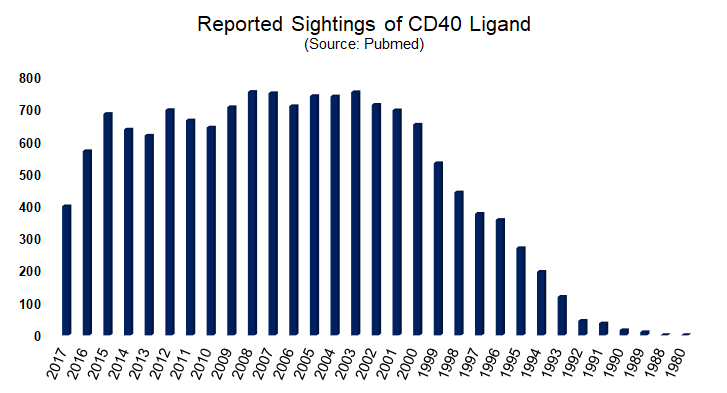Antibody-points Bulletin: CD40 ligand
Antibody-points Bulletin: CD40LG
BOLO:
CD40 Ligand

Source: Swiss-Model
CC License
PID: P29965
GID: 959
Nicknames: CD40L
AKA: IGM, IMD3, TRAP, gp39, CD154, HIGM1, T-BAM, TNFSF5, hCD40L
Vitals:
Origins: Xq26.3
DNA: NC_000023.11 12214 bp, (136648177..136660390)
RNA: NM000074.2 3982 bp
Exons: 5
Protein: 386 aa, 43.8 kDa
Description:
The protein encoded by this gene is expressed on the surface of T cells. It regulates B cell function by engaging CD40 on the B cell surface. A defect in this gene results in an inability to undergo immunoglobulin class switch and is associated with hyper-IgM syndrome.
Cytokine that binds to CD40/TNFRSF5 (PubMed:1280226). Costimulates T-cell proliferation and cytokine production. Its cross-linking on T-cells generates a costimulatory signal which enhances the production of IL4 and IL10 in conjunction with the TCR/CD3 ligation and CD28 costimulation (PubMed:8617933). Induces the activation of NF-kappa-B and kinases MAPK8 and PAK2 in T-cells. Induces tyrosine phosphorylation of isoform 3 of CD28 (PubMed:15067037). Mediates B-cell proliferation in the absence of co-stimulus as well as IgE production in the presence of IL4. Involved in immunoglobulin class switching.
Can be cleaved into following 2 chains: CD40 ligand soluble form, and CD40 ligand membrane form.
In early HIV infection, CD40L expression contributes to the immunological control of viral replication by inducing HIV-suppressive chemokines and supporting the production of anti-HIV antibodies and cytotoxic T cells. However, by activating antigen-presenting cells, such as dendritic cells and macrophages, CD40L can also lead to increased CD4+ T cell activation, which promotes the replication of HIV in these lymphocytes.
Last Known Addresses:
• Cell Membrane
• Cell Surface
Known Hangouts:
Most likely to be found in lymph nodes, tonsils, appendix, bone marrow, and spleen
Source: Human Protein Atlas
Gang Associations:
B Cell Differentiation
• B Cell Proliferation
• Immunoglobulin Secretion
• Inflammatory Response
• Isotype Switching
• Leukocyte Cell-Cell Adhesion
• Negative Regulation of Apoptotic Process
• Platelet Activation
• Positive Regulation of Endothelial Cell Apoptotic Process
• Positive Regulation of Interleukin-10 Production
• Positive Regulation of Interleukin-12 Production
• Positive Regulation of Interleukin-4 Production
• Positive Regulation of NF-Kappa-b Transcription Factor Activity
• Positive Regulation of T Cell Proliferation
• Regulation of Immune Response
• Regulation of Immunoglobulin Secretion
• T Cell Costimulation
• Tumor Necrosis Factor-Mediated Signaling Pathway
•
Known Weaknesses: Dapirolizumab Pegol
for systemic lupus erythematosusMeans of Capture:
Related post (13)
Top 20 Gene/Protein Antibodies
Conducting a literature search of over 3.5 million articles, we compiled a list of some of the most popular potential antibody t..
Top Trending Gene Targets for Antibodies
Now that whole genome sequence is known, it is interesting to see what genes have captured the research communities attention. A..
Antibody-points Bulletin: Mucin-20
Mucin-20 is a member of the mucin protein family. Mucins are high molecular weight glycoproteins secreted by many epithelial tis..
Antibody-points Bulletin: GSK3A
GSK3A encodes a multifunctional Ser/Thr protein kinase that is implicated in the control of several regulatory proteins includin..








